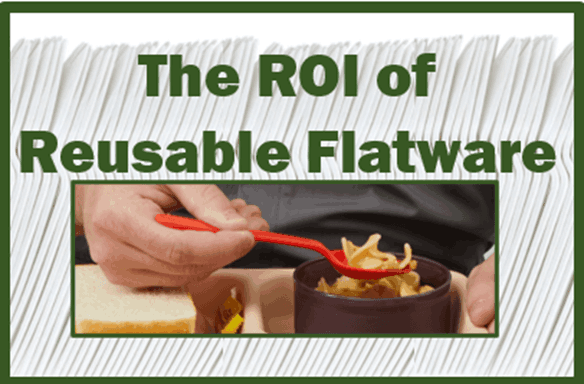One of the first changes that the pandemic brought about was an increased demand in disposable meal packaging, flatware and drinkware that created shortages and inflated prices. Over time, pricing and demand have regulated themselves, but the use of disposable flatware is more common now than pre-covid. Along with increasing expenses, the shift to single use packaging and flatware has created an increase in non-food waste in foodservice with a negative environmental impact.
For those foodservice outlets that have the ability to wash and store reusable flatware, making the switch offers a quick financial payoff. Let’s explore changing from a disposable spork to a reusable one to show the timeframe needed to reach a financial benefit.
The cost for a case of 1,000 disposable medium weight sporks is $14.99. That’s less than two cents per spork, which seems pretty inexpensive. But keep in mind, if you serve 335 inmate meals at each day part, you’re using one full case and opening up a second, just to get through the day.
Our Correctional Co-polymer Reusable Sporks come in a case of 400 at the price of $45 or just over eleven cents apiece. We also have a lower priced reusable option, the Economy Spork which is available in the same size case of 400 but costs only $35 per case. The Economy Spork has a per piece price just under nine cents each.
To simplify this example, let’s start with a facility that has 400 inmates. That means that you need one case of reusable flatware to feed the population. Knowing how facilities operate, you would need to have two sets of sporks, one spork per inmate with a meal and then one spork that’s in the wash cycle. Because these are reusable, one day or one hundred days, it’s still two cases of sporks. With our Correctional Spork, your investment in two cases is $90, and then to be realistic – let’s add in a third case, because some of the sporks won’t come back or they will end up in the trash, even thought we offer the bright security orange color so it’s easy to spot them in the garbage when that happens. Three cases of sporks should cover your population of 400, with a cost of $135. For that same $135, you can purchase 9 cases of disposable sporks which is 9000 total individual sporks. Because you’re using 400 of these at every meal, 1200 sporks are required every day. If you started using these on a Monday, you wouldn’t have enough sporks to get through your second meal on the following Monday. In seven days, you will use 8400 disposable sporks, and that leaves you with only half the sporks you need to get though another day.
Once you’re through day 8, you’re saving money with your reusable flatware – and we’ve covered having two sets of flatware, once in the wash and one with a meal, and an extra case of 400 to cover loss in the trash. And that’s with our best quality reusable flatware.
Now let’s switch to the economy sporks. These cost 25% less than our Correctional Sporks. For three cases or 1200 of these sporks, you’ll spend $105. For that amount, you can purchase only 7 cases of disposable sporks. Those 7 cases will only get you through 5 full days and part of the next day, but by the end of day 6 – you’re saving money if you’re using the Reusable Economy Spork.
In both of these examples, there are some additional considerations that make this an even quicker payoff. First, we didn’t include the cost to have the disposable flatware shipped to you. Once case of reusable sporks and one case of disposable sporks are probably similar in cost to ship, but you need a lot more cases of disposables. You can make the point that there’s a cost to wash these, so let’s call it even, but really – aren’t you washing meal trays or cook ware anyway? And then there’s the storage space needed for the disposable flatware. Unless you’re receiving product in weekly, you need to have some dedicated space for these cases of product. And finally, there’s the trash. With the increase in single use packaging, there’s also been increased costs for excess garbage and collection.
Making the switch from disposable flatware to reusable adds up to savings quickly, and who isn’t looking to reduce their costs these days?


















